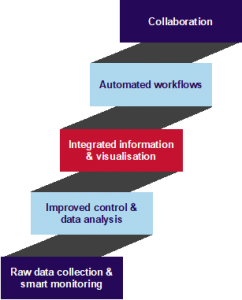
Many of Astral’s clients own and operate large-scale physical assets. The ability to operate and manage these assets effectively and efficiently directly effects their product quality and profitability. In recent times, there has been a qualitative leap in asset and process optimisation, enabling sophisticated use of information, data and technology. In this briefing, we identify key optimisation and productivity improvement areas based on our experience working with these industries.
Data-driven value chain optimisation
Data management and analytics tools generate ‘actionable intelligence’ to integrate the end-to-end business value chain. A change at any stage of the value chain (e.g. demand from a customer, delays in shipping) impacts all the others (e.g. extraction and processing volumes).
Actionable intelligence provides greater visibility of the whole value chain, enabling instantaneous management of changes and impacts by stakeholders anywhere in the ecosystem.
This reduces costs associated with delays, down-time, excess or insufficient product availability, process redundancies and repeated work.
Production Optimisation
The main production costs in asset-intensive industries are human resources, raw material costs, and costs of operating assets and infrastructure. Integration of information flows across the complete product lifecycle increases asset ‘up time’ and improves human effort by enhancing process synergies.

Figure 1: Key optimisation and productivity improvement areas
For example, maintenance actions can be timed to coincide with reduced production requirements. This effectively turns maintenance from being a ‘cost centre’ into an ‘opportunistic driver’ through asset performance improvements.
Asset Optimisation
Optimisation of the value chain and the production process relies on the optimisation of the assets themselves. Asset availability remains one of the asset-intensive industry’s most important performance metric. Availability correlates directly with timely information on asset condition information to enable predictive maintenance and asset health care. Actionable intelligence can be used to maximise asset utilisation, performance, energy efficiency and overall return on investment.
Information Driven Optimisation of Value Chain, Production and Assets
Astral understands that most asset-intensive firms have areas of operation (e.g. selected manufacturing plants or mine sites) that have reached an ‘optimised’ level across all three areas. In contrast, others remain at a (lower) managed or reactive level of maturity.
Achieving the nirvana of optimisation across an enterprise is challenging due to the complexities of transformation, which include the adoption of enterprise-wide enabling platforms (e.g. OSI-PI, SAP, Aveva, MS365, OpenText xECM, Autodesk Revit and Navisworks) and significant cultural change. This includes developing more sophisticated data governance capabilities to provide solid foundations for the data-driven enterprise.
However, in our experience, even modest initiatives to align collaborative capabilities, process automation, integrated information management, and data visualisation and analytics will contribute to the evolution of an integrated operational model. This will help generate the actionable intelligence that delivers value chain, process and asset optimisation dividends.
Integrated Operations Enterprise Model
Defining a clear strategy for enterprise integration and continually refining and updating the implementation roadmap will help move the business closer to an optimised business model.
This is becoming more achievable as information management practices and key platforms mature, offering improved options for integration and more rapid deployment and adoption pathways.

Figure 2: Integrated Operations Enterprise Model (Sinclair/Honeywell)
